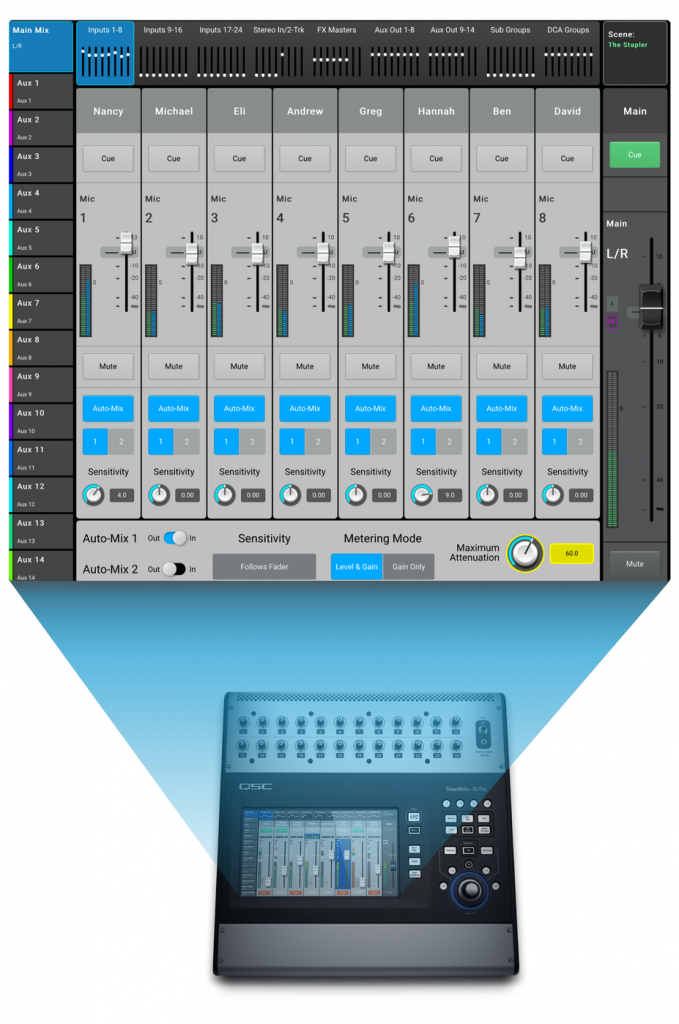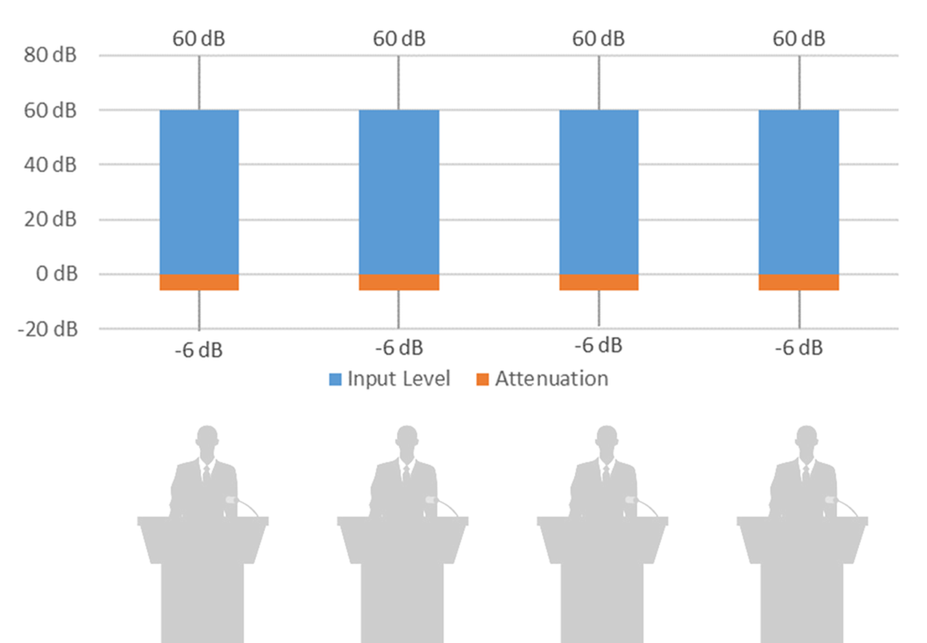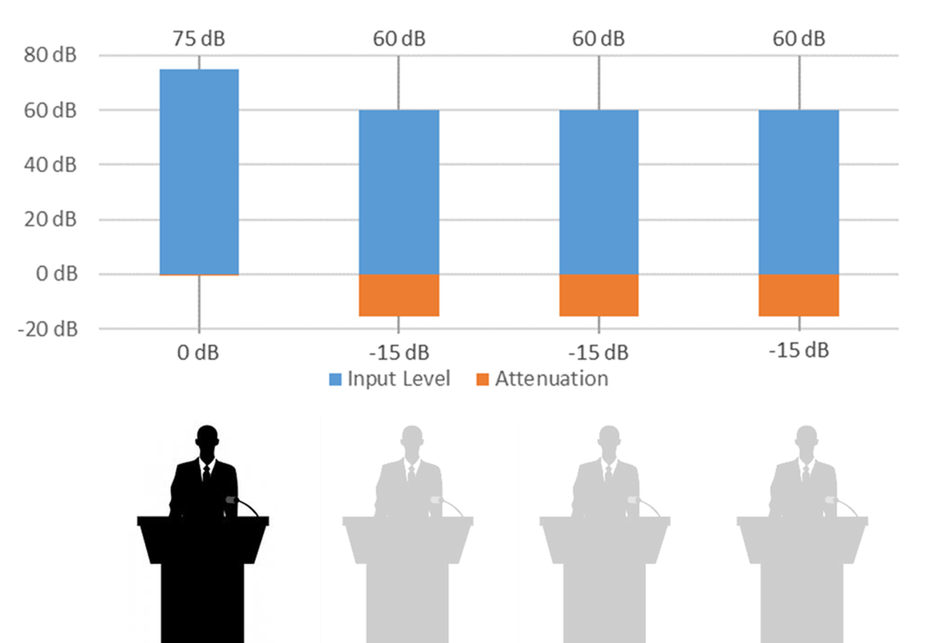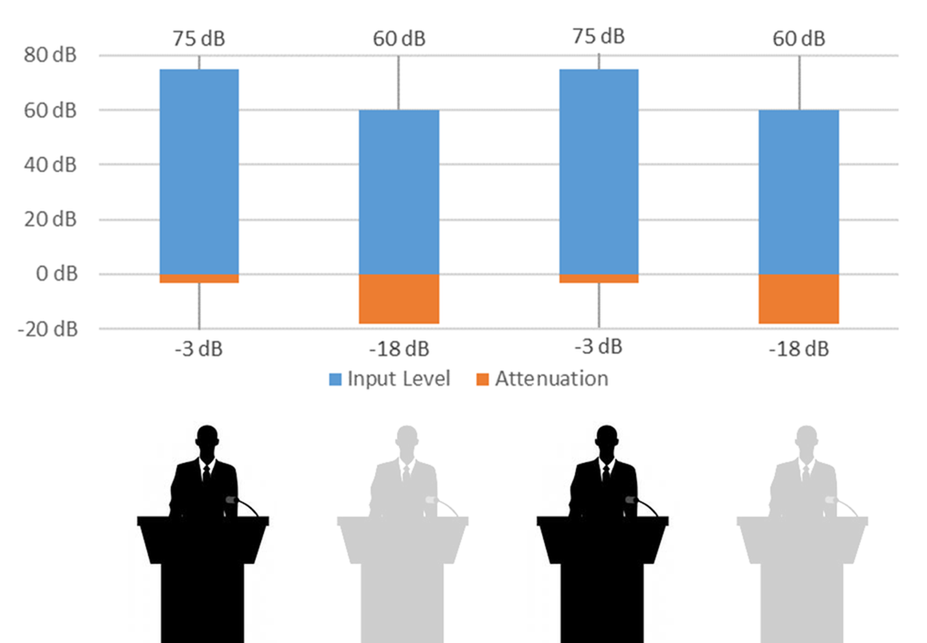An auto mixer, or automatic microphone mixer, is a live sound-mixing tool that automatically reduces the volume level of a microphone’s audio signal when it is not used. This is particularly valuable when several microphones are open at the same time, reducing extraneous noise. In this article, we will describe how the Auto Mixer function works in QSC TouchMix-30 Pro digital mixer.
What is it for?
Auto mixers are primarily used for speech applications such as panel discussions during broadcasts and at conferences and seminars. They can also be used to mix actors’ wireless microphones in theater productions. Auto mixers are also frequently employed in settings where it is expected that a live sound operator will not present at all times, like in courtrooms and city council chambers.
While a skilled mixing engineer can greatly enhance a live sound performance, it is quite difficult to anticipate, with perfect accuracy, which participant will speak next in a spontaneous discussion. Sudden interjections by panelists may be lost completely, or the beginning of a word may be absent because the operator does not respond quickly enough.A properly adjusted auto mixer will do this automatically, bringing down the level of those panelists who are not talking while allocating more gain to those who are. An auto mixer will reduce feedback, minimize extraneous noise (such as paper rustling from panelists or HVAC) and improve sound quality by reducing the comb filtering that occurs when a talker is picked-up by multiple microphones.
Although well-suited for speech applications, auto mixers have limited use in mixing musical performance. Attempting to mix a band using an auto mixer will yield weirdly unsatisfactory results. That said, some users report good results using auto mixers on groups of similar items such as a horn section or backing vocals.
How does it work?
Auto mixers balance multiple sound sources based on each source’s level, quickly adjusting the various signal levels automatically. In the general context of sound mixing, there are two different approaches to auto mixing; gain sharing or gating design.
The TouchMix-30 Pro digital mixer features a gain sharing auto mixer which works by comparing the signal levels of the assigned channels and applying an algorithm that determines which talker (or talkers) is (are) currently speaking. The Auto mixer then sends a control command to the channels, allocating more gain to the channels with an active talker and less to the channels with an inactive talker. The Auto mixer simply rides gain on the assigned channels and does not have any effect on signal routing. The Auto mixer will affect any Aux-mixes that are assigned post-fader but will not affect any pre-fader Aux sends.
One important parameter of the auto mixer is the maximum attenuation, which is essentially a threshold on how much total attenuation is applied to any channel. At its default setting of – 60 dB, the auto mixer is going to apply up to, but no more than, 60 dB of attenuation to any channel included in the auto mix. The higher the attenuation, the less noise is going to be heard in the system. For speech applications, the default of – 60 dB is standard.

For musical applications, the auto mixer will work best when the maximum attenuation is set much lower than 60 dB, typically between 3 dB and 6 dB. As an example, if you want to use auto mixing on a full horn section to help maintain a certain level within that group of instruments, the appropriate maximum attenuation should be 3 dB. When all musicians are playing, each of their channels will be attenuated by 3 dB. Then, when a particular player takes a solo, the auto mixer will allow more gain to that particular channel, providing the same effect as if the mix engineer was increasing the level for the soloist.
Gain Sharing in Practice
Let’s look at a typical panel discussion configuration. In the illustration below, there are four talkers, none of whom is speaking. Each talker’s microphone is picking up 60 dB of ambient noise. Since the signal from each microphone is the same, all channels are attenuated by 6 dB.

In the next illustration, the first talker speaks and the level of his microphone increases by 15 dB. The Auto mixer removes the attenuation from his channel and applies 15 dB of attenuation to the other three channels.

Next, talker 1 and 3 are speaking simultaneously, and therefore the Auto mixer will apply 3 dB of attenuation to talkers 1 and 3 while further attenuating talkers 2 and 4.

The result is that the combined gain of all microphones remains constant so that the ambient noise heard from the loudspeakers will stay consistent, as well. In addition, there is never one instance where all four microphones are un-attenuated, so the potential for feedback is strongly reduced.
Why using two Auto Mixers?
We have just discussed using an auto mixer for a typical panel discussion with four talkers, but there are many applications where there are more talkers with, often, varying degrees of presentation skills. A classic example is a TV show, where four professional journalists are talking to four guests. Using two, independent auto mixers becomes extremely useful, as different settings can be applied to each group of talkers, allowing, for example, more attenuation to be dialed-in for the unexperienced talkers.
In the musical world, having two separate auto mixers to manage level changes for a horn-section and a group of backing vocal singers is very useful, as they each require specific settings. The good news is that, featured as standard, the very compact and highly transportable TouchMix-30 Pro features two independent, gain sharing auto mixers on all its 24 mic/line input channels. More than enough to handle any type of applications requiring one, or two, auto mixer(s).

Conclusion
As explained above, auto mixers are most commonly used for speech applications such as conferences, presentations or panel discussions in which there are multiple talkers and multiple microphones. An Auto mixer will reduce feedback, minimize extraneous noise and improve sound quality by reducing the comb filtering that occurs when multiple microphones pick up one, or more, talker. To learn more about auto mixing and how to adjust all its specific parameters, watch our two-part training videos here (Part 1 / Part 2). Happy auto mixing!
Christophe Anet
Derniers articles parChristophe Anet (voir tous)
- History, Development and Applications of Column Loudspeakers - May 30, 2025
- Why is Dynamic Range so important? - May 30, 2023
- Differences between Flown and Floor-Mounted Subwoofer Deployments - May 2, 2023
